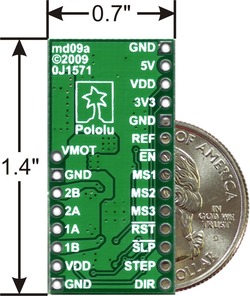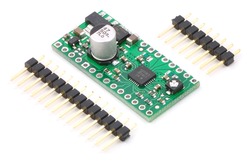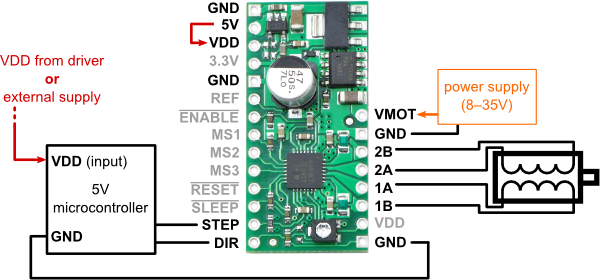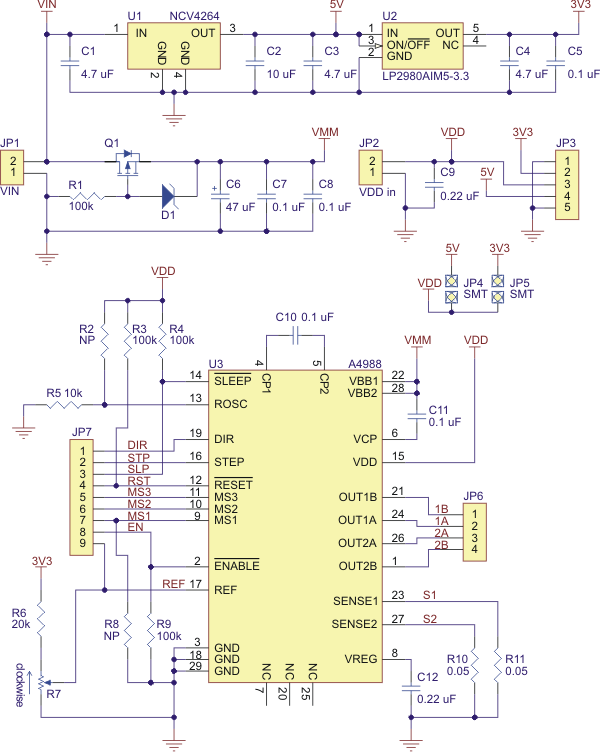

A4988 Stepper Motor Driver Carrier with Voltage Regulators
The A4988 stepper motor driver carrier with voltage regulators is a breakout board for Allegro’s easy-to-use A4988 microstepping bipolar stepper motor driver and is a drop-in replacement for the A4983 stepper motor driver carrier with voltage regulators. The board has two voltage regulators (5 V and 3.3 V), eliminating the need for separate logic and motor supplies. The driver features adjustable current limiting, overcurrent protection, and five different microstep resolutions. It operates from 8 – 35 V and can deliver up to 2 A per coil.
 |
| A4983/A4988 stepper motor driver carrier with voltage regulators with dimensions. |
|---|
This product is a carrier board or breakout board for Allegro’s A4988 DMOS Microstepping Driver with Translator and Overcurrent Protection; we therefore recommend careful reading of the A4988 datasheet (380k pdf) before using this product. This stepper motor driver lets you control one bipolar stepper motor at up to 2 A output current per coil (see the Power Dissipation Considerations section below for more information). Here are some of the driver’s key features:
This carrier has reverse power protection on the main power input and built-in 5 V and 3.3 V voltage regulators that eliminate the need for separate logic and motor supplies and let you control the driver with microcontrollers powered at 5 V or 3.3 V. We also sell a smaller version of the A4988 carrier without voltage regulators.
Like nearly all our other carrier boards, this product ships with all surface-mount components—including the A4988 driver IC—installed as shown in the product picture.
Some unipolar stepper motors (e.g. those with six or eight leads) can be controlled by this driver as bipolar stepper motors. For more information, please see the frequently asked questions. Unipolar motors with five leads cannot be used with this driver.
The A4988 stepper motor driver carrier with voltage regulators comes with one 1?14-pin breakaway 0.1" male header and one 1?8-pin breakaway 0.1" male header. The headers can be soldered in for use with solderless breadboards or 0.1" female connectors. You can also solder your motor leads and other connections directly to the board.
 |
 |
| Minimal wiring diagram for wiring a 5V microcontroller to an A4983/A4988 stepper motor driver carrier with voltage regulators (full-step mode). |
|---|
The driver requires a logic supply voltage (3 – 5.5 V) to be connected across the VDD and GND pins and a motor supply voltage of (8 – 35 V) to be connected across VMOT and GND. The logic voltage can be supplied from an external source, such as that powering the logic of the rest of the system, or by jumpering the output of the 5 V or 3.3 V voltage regulator outputs to VDD. There are also surface-mount pads that allow VDD selection to be made by making a solder bridge across the appropriate pads. Note that the driver’s regulators can also be used to power other electronics in the system, such as the controlling MCU.
The motor power supply should be capable of delivering the expected currents for the stepper motors being used (peaks up to 4 A).
Four, six, and eight-wire stepper motors can be driven by the A4988 if they are properly connected; a FAQ answer explains the proper wirings in detail.
Warning: Connecting or disconnecting a stepper motor while the driver is powered can destroy the driver. (More generally, rewiring anything while it is powered is asking for trouble.)
 |
Stepper motors typically have a step size specification (e.g. 1.8° or 200 steps per revolution), which applies to full steps. A microstepping driver such as the A4988 allows higher resolutions by allowing intermediate step locations, which are achieved by energizing the coils with intermediate current levels. For instance, driving a motor in quarter-step mode will give the 200-step-per-revolution motor 800 microsteps per revolution by using four different current levels.
The resolution (step size) selector inputs (MS1, MS2, MS3) enable selection from the five step resolutions according to the table below. MS1 and MS3 have internal 100kΩ pull-down resistors and MS2 has an internal 50kΩ pull-down resistor, so leaving these three microstep selection pins disconnected results in full-step mode. For the microstep modes to function correctly, the current limit must be set low enough (see below) so that current limiting gets engaged. Otherwise, the intermediate current levels will not be correctly maintained, and the motor will effectively operate in a full-step mode.
| MS1 | MS2 | MS3 | Microstep Resolution |
|---|---|---|---|
| Low | Low | Low | Full step |
| High | Low | Low | Half step |
| Low | High | Low | Quarter step |
| High | High | Low | Eighth step |
| High | High | High | Sixteenth step |
Each pulse to the STEP input corresponds to one microstep of the stepper motor in the direction selected by the DIR pin. Note that the STEP and DIR pins are not pulled to any particular voltage internally, so you should not leave either of these pins floating in your application. If you just want rotation in a single direction, you can tie DIR directly to VCC or GND. The chip has three different inputs for controlling its many power states: RST, SLP, and EN. For details about these power states, see the datasheet.
To achieve high step rates, the motor supply is typically much higher than would be permissible without active current limiting. For instance, a typical stepper motor might have a maximum current rating of 1 A with a 5Ω coil resistance, which would indicate a maximum motor supply of 5 V. Using such a motor with 12 V would allow higher step rates, but the current must actively be limited to under 1 A to prevent damage to the motor.
The A4988 supports such active current limiting, and the trimmer potentiometer on the board can be used to set the current limit. One way to set the current limit is to put the driver into full-step mode and to measure the current running through a single motor coil without clocking the STEP input. The measured current will be 0.7 times the current limit (since both coils are always on and limited to 70% in full-step mode). Please note that the current limit is dependent on the Vdd voltage.
Another way to set the current limit is to measure the voltage on the REF pin and to calculate the resulting current limit (the current sense resistors are 0.05Ω). See the A4988 datasheet for more information.
The A4988 driver IC has a maximum current rating of 2 A per coil, but the actual current you can deliver depends on how well you can keep the IC cool. The carrier’s printed circuit board is designed to draw heat out of the IC, but to supply more than approximately 1 A per coil, a heat sink or other cooling method is required.
This product can get hot enough to burn you long before the chip overheats. Take care when handling this product and other components connected to it.
Please note that measuring the current draw at the power supply does not necessarily provide an accurate measure of the coil current. Since the input voltage to the driver can be significantly higher than the coil voltage, the measured current on the power supply can be quite a bit lower than the coil current (the driver and coil basically act like a switching step-down power supply). Also, if the supply voltage is very high compared to what the motor needs to achieve the set current, the duty cycle will be very low, which also leads to significant differences between average and RMS currents.
 |
| Schematic diagram of the md09a A4988 stepper motor driver carrier with regulators. |
|---|
Note: This board is a drop-in replacement for the original A4983 stepper motor driver carrier with voltage regulators. The key difference is that the newer A4988 offers overcurrent protection that the A4983 lacks; it is otherwise virtually identical to the A4983.
 |
Pololu Universal Aluminum Mounting Hub for 5mm Shaft Pair |
 |
A4988 Stepper Motor Driver Carrier |
 |
Stepper Motor: Unipolar/Bipolar, 200 Steps/Rev, 42x48mm, 4V, 1200mA |
Data sheet
Manufacturer BTC Korporacja sp. z o. o. Lwowska 5 05-120 Legionowo Poland sprzedaz@kamami.pl 22 767 36 20
Responsible person BTC Korporacja sp. z o. o. Lwowska 5 05-120 Legionowo Poland sprzedaz@kamami.pl 22 767 36 20
Shield with dual-channel DC motor driver for Arduino. It has an operating voltage from 7 to 30 V and a continuous current of up to 1.2 A. It can be controlled by a PWM signal or by means of built-in buttons. Cytron SHIELD-3AMOTOR
The X-NUCLEO-IHM12A1 is a low voltage dual brush DC motor driver expansion board based on the STSPIN240 for STM32 Nucleo. It provides an affordable and easy-to-use solution for the implementation of portable motor driving applications such as thermal printers, robotics and toys
Dual DC motor controller designed for Raspberry Pi, which enables the engine to be supplied with voltage in the 4.5-28V range and power consumption in continuous operation of 2.6A (5A in peak) of two DC motors. Pololu 2762
DC motor driver that allows you to control the movement of two drives using the I2C interface. Board with soldered connectors. Pololu 5048
No product available!
DRV8711 stepper motor driver module powered by 8-50V voltage and 4A operating current. The controller allows you to control the movement of the engine with up to 9 different resolutions. Configuration via SPI interface. Pololu 3730
Module with a stepper motor driver based on the DRV8434A system. It allows the bipolar motor to be supplied with current up to 1.2 A per phase and with a voltage from 4.5 V to 45 V. Communication via the SPI interface. Pololu 3766
No product available!
A dual-channel BLDC controller capable of controlling two motors simultaneously using precise FOC vector control. Equipped with the EG Driver Chip, an INA181A2 amplifier, and a 1 mΩ sensing resistor, it provides accurate current measurement and stable operation at peak currents up to 12 A. It supports a variety of encoders and sensors, and its compatibility with ESP32 modules makes it easy to integrate into projects. Makerbase DUAL FOC PLUS
Pololu Jrk 21v3 USB Motor Controller with Feedback (Fully Assembled)
No product available!
KAmodMPC17C724 is a module with a double MP bridge bridge type MPC17C724. The system allows you to control two DC brush motors or one bipolar stepping motor. The controller operates at a voltage range of 2.7 - 5.5 V and can work with motors with power consumption up to 0.4 A.
DC motor driver that allows you to control the movement of two drives using the I2C interface. Board with soldered connectors. Pololu 5042
No product available!
The ODrive3.6 ESC speed controller is designed to power two three-phase brushless motors in various applications, such as driving robots, walking robots or gimbals. Supports input voltage range from 12 V to 56 V and maximum current up to 60 A. Makerbase ODrive3.6
No product available!
A module with a two-channel DC motor driver based on the TB6612FNG system. Designed for Wemos D1 Mini
Single-channel DC motor controller that allows the motor to be controlled with a voltage range of 6-30V and a current of up to 13A. Allows engine speed control using PWM signals. Cytron MD13S
Direct current motor driver (DC) with a working voltage from 5 to 30 V and a maximum continuous current of 30 A. It can be controlled by a PWM signal or by means of built-in buttons. Cytron MD30C
No product available!
Pololu G2 18v15 High Power is a miniature DC motor controller. Power supply for the controller: 6.5 ... 30 V. Current efficiency of the module: 15 A. The module has protection against back voltage and overvoltages. Pololu 1363
No product available!
STSPIN220 stepper motor driver module with a low voltage range of 1.8 ... 10V and 1.1A working current. The controller allows you to control the motor motion up to 9 different resolutions (up to 1/256 steps). Pololu 2876

A4988 Stepper Motor Driver Carrier with Voltage Regulators
